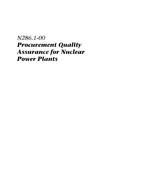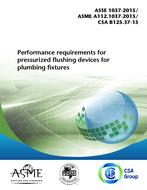Click here to purchase
Preface
This is the third edition of the CSA A3000, Cementitious materials compendium. It supersedes the previous editions published in 2003 and 1998.
A3001-08 Cementitious materials for use in concrete
1 Scope
1.1
This Standard addresses the following aspects of cementitious materials:
(a) their definitions;
(b) their chemical, physical, and uniformity requirements;
(c) the tests required;
(d) the procedures for inspection and sampling; and
(e) the units of measurement, packaging, marking, and storage.
1.2
The cementitious materials for use in concrete are classified as follows in this Standard:
(a) portland cement;
(b) blended hydraulic cement;
(c) portland-limestone cement;
(d) supplementary cementing materials; and
(e) blended supplementary cementing materials.
1.3
In CSA Standards, “”shall”” is used to express a requirement, i.e., a provision that the user is obliged to satisfy in order to comply with the standard; “”should”” is used to express a recommendation or that which is advised but not required; “”may”” is used to express an option or that which is permissible within the limits of the standard; and “”can”” is used to express possibility or capability. Notes accompanying clauses do not include requirements or alternative requirements; the purpose of a note accompanying a clause is to separate from the text explanatory or informative material. Notes to tables and figures are considered part of the table or figure and may be written as requirements. Annexes are designated normative (mandatory) or informative (non-mandatory) to define their application.
1.4
Values are given in SI (metric) units. The values given in parentheses are for information only.
—————————————————————-
A3002-08 Masonry and mortar cement
1 Scope
1.1
This Standard specifies the requirements for masonry and mortar cement for use in masonry mortar.
1.2
In CSA Standards, “”shall”” is used to express a requirement, i.e., a provision that the user is obliged to satisfy in order to comply with the standard; “”should”” is used to express a recommendation or that which is advised but not required; “”may”” is used to express an option or that which is permissible within the limits of the standard; and “”can”” is used to express possibility or capability. Notes accompanying clauses do not include requirements or alternative requirements; the purpose of a note accompanying a clause is to separate from the text explanatory or informative material. Notes to tables and figures are considered part of the table or figure and may be written as requirements. Annexes are designated normative (mandatory) or informative (non-mandatory) to define their application.
—————————————————————-
A3003-08 Chemical test methods for cementitious materials for use in concrete and masonry
1 Scope
1.1 General
Test methods in this Standard and the “”D series”” test methods of CSA A3004 address the chemical analysis of hydraulic cement and supplementary cementing materials.
Note: For frequencies of chemical testing, see Table 1 of CSA A3004-A1.
1.2
In CSA Standards, “”shall”” is used to express a requirement, i.e., a provision that the user is obliged to satisfy in order to comply with the standard; “”should”” is used to express a recommendation or that which is advised but not required; “”may”” is used to express an option or that which is permissible within the limits of the standard; and “”can”” is used to express possibility or capability. Notes accompanying clauses do not include requirements or alternative requirements; the purpose of a note accompanying a clause is to separate from the text explanatory or informative material. Notes to tables and figures are considered part of the table or figure and may be written as requirements. Annexes are designated normative (mandatory) or informative (non-mandatory) to define their application.
—————————————————————-
A3004-08 Test methods and standard practices for cementitious materials for use in concrete and masonry
1 Scope
1.1
This Standard specifies the requirements of test methods and standard practices for hydraulic cements, supplementary cementing materials, and blended supplementary cementing materials.
1.2
This Standard is divided into test methods and standard practices, numbered as follows:
(a) A1 to A6, representing dry tests;
(b) B1 to B7, representing paste tests;
(c) C1 to C9, representing mortar tests;
(d) D1 and D2, representing tests on limestone; and
(e) E1, representing the evaluation of alternative supplementary materials.
1.3
Each test method or standard practice contains a scope, reference publications, summary of test, equipment and materials, and test procedure.
1.4
In CSA Standards, “”shall”” is used to express a requirement, i.e., a provision that the user is obliged to satisfy in order to comply with the standard; “”should”” is used to express a recommendation or that which is advised but not required; “”may”” is used to express an option or that which is permissible within the limits of the standard; and “”can”” is used to express possibility or capability. Notes accompanying clauses do not include requirements or alternative requirements; the purpose of a note accompanying a clause is to separate from the text explanatory or informative material. Notes to tables and figures are considered part of the table or figure and may be written as requirements. Annexes are designated normative (mandatory) or informative (non-mandatory) to define their application.
—————————————————————-
A3005-08 Test equipment and materials for cementitious materials for use in concrete and masonry
1 Scope
1.1
This Standard specifies the materials and equipment used in testing hydraulic cements, supplementary cementing materials, and blended supplementary cementing materials.
1.2
In CSA Standards, “”shall”” is used to express a requirement, i.e., a provision that the user is obliged to satisfy in order to comply with the standard; “”should”” is used to express a recommendation or that which is advised but not required; “”may”” is used to express an option or that which is permissible within the limits of the standard; and “”can”” is used to express possibility or capability. Notes accompanying clauses do not include requirements or alternative requirements; the purpose of a note accompanying a clause is to separate from the text explanatory or informative material. Notes to tables and figures are considered part of the table or figure and may be written as requirements. Annexes are designated normative (mandatory) or informative (non-mandatory) to define their application.
Product Details
- Edition:
- 3rd
- Published:
- 09/01/2008
- ISBN(s):
- 9781554364558
- Number of Pages:
- 360
- File Size:
- 1 file , 4.7 MB


